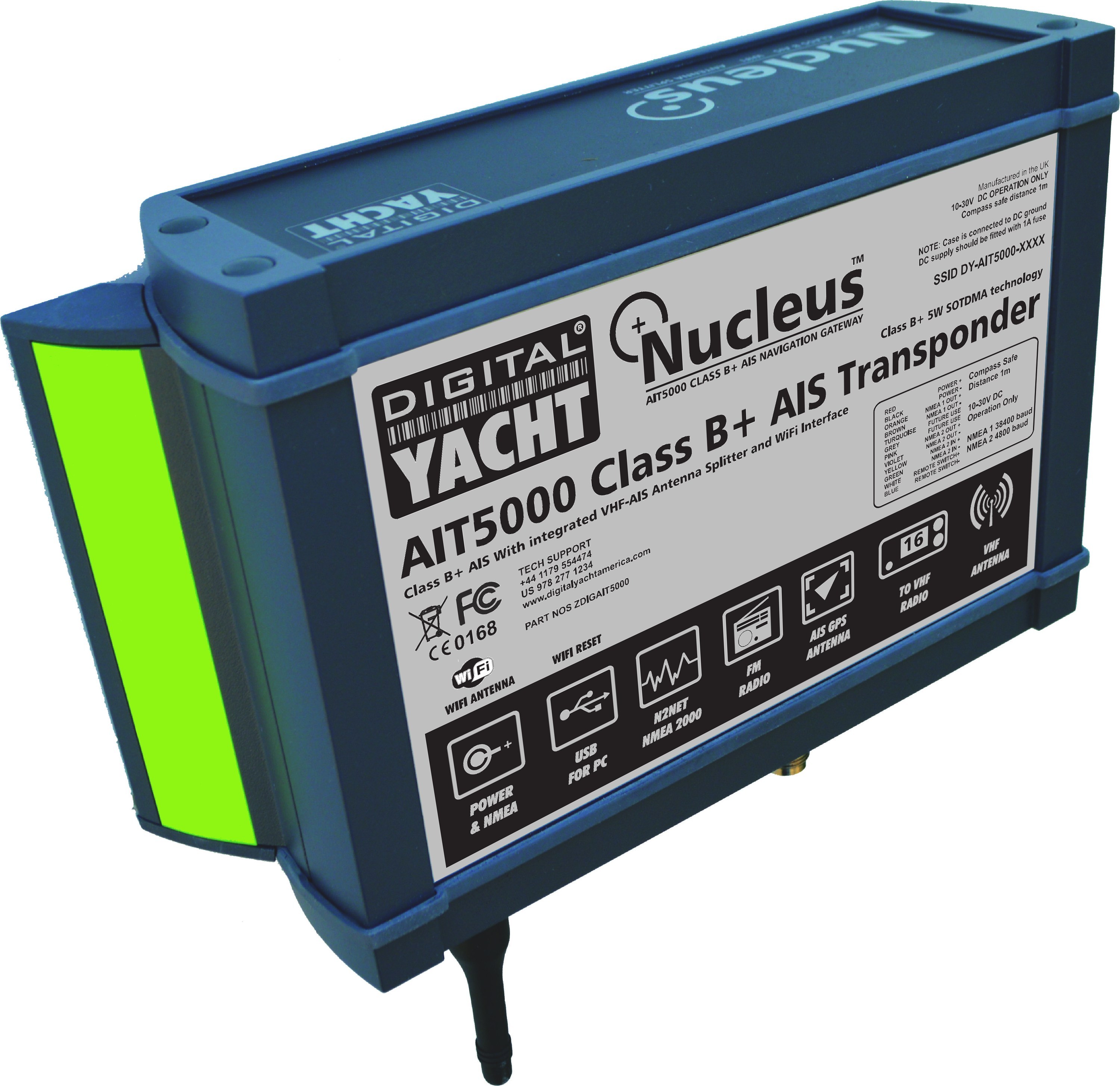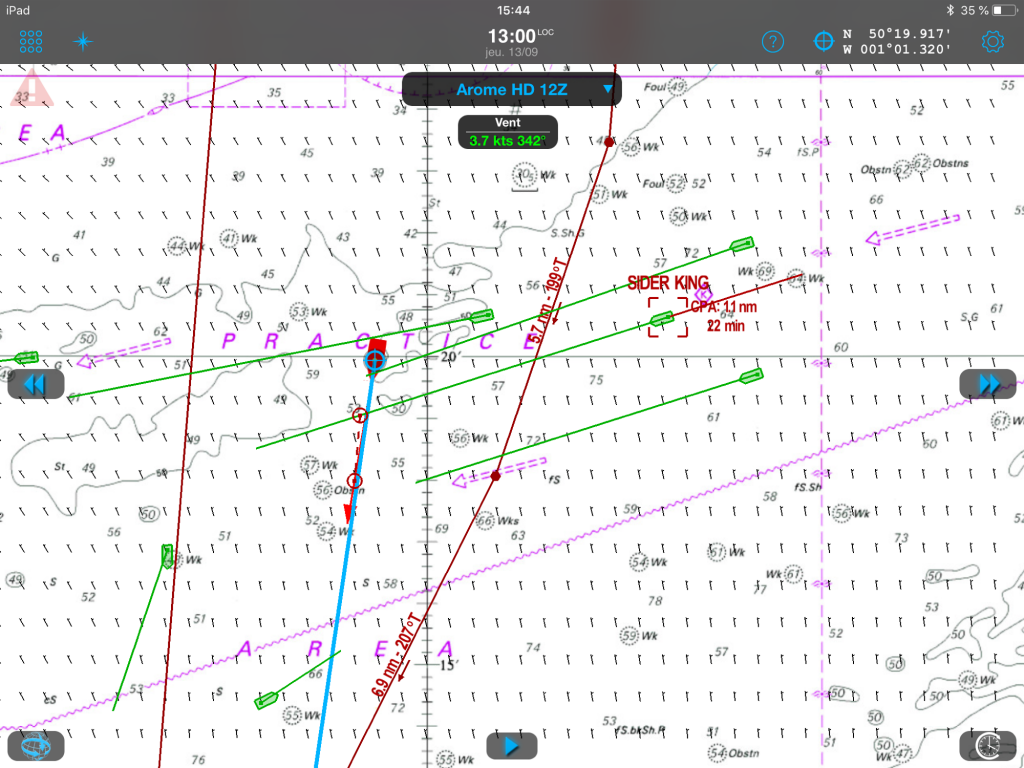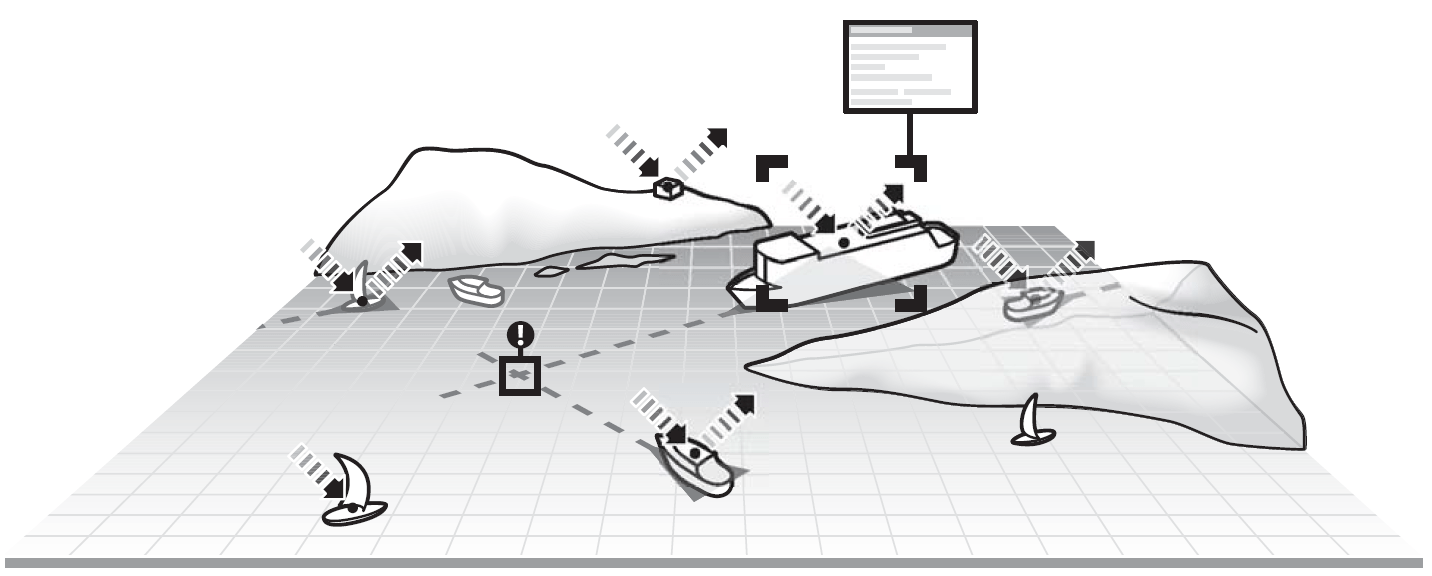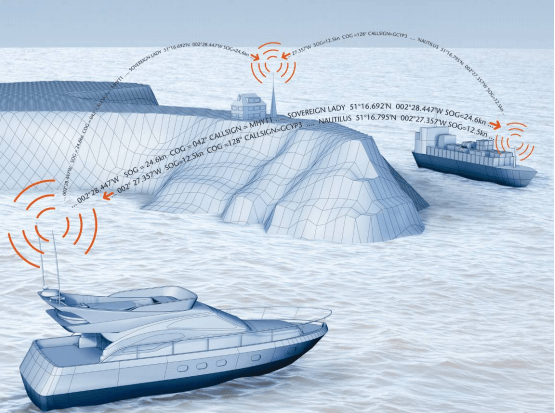
The new AIS AIT5000 transponder (from Digital Yacht) increases transmission rate depending on ship speed.
A new generation of transponder (¹) AIS Class B+ claims to make pleasure boats more visible. Here's how…
Automatic identification systems (AIS) may have originally been designed as an anti-collision system for commercial shipping, but in recent years, they have also become a popular safety aid for recreational boats.
AIS not only allows you to see and be seen, even hidden by darkness, the fog, land or distance traveled, but it also becomes a useful navigation tool now that transmitters are installed on the beacons, buoys and other navigation aids.
AIS-SART (Search And Rescue Transponders) have also been approved for use as man overboard devices, which can be captured by SAR helicopters as well as surface craft equipped with an AIS system.
Until recently, however, the AIS used a two-tiered system :
- The transmitters of class A, obligatory on all ships over 300 Tx or more 12 passengers, fishing boats > 15meters.
- The transmitters of class B which allow smaller fishing and recreational vessels to adopt a low-power, lower-cost transponder.
The problem being that recreational boats equipped with Class B AIS transponders may not be as visible as you might think., especially in busy areas with many AIS targets. From now on, a change in the rules and a new generation of AIS transponders class B+ contribute to standardizing the situation. So what are the changes and how they affect potential buyers? ?
How AIS works
To explain the changes, you must first understand how the AIS system works. An AIS transponder includes a GPS receiver and a VHF data transmitter. The transponder transmits this GPS position in digital form on two VHF channels dedicated to AIS (161,975 MHz and 162,025 MHz). To avoid simultaneous transmission of several devices, AIS transponders use a system called TDMA (Time Division Multiple Access), which means : time division multiple access.
Each transponder communicates with other users in the area to avoid conflicts and claim its own short time interval of 26,6 milliseconds. The system allows up to 4500 ships to sail in the same vicinity, by automatically giving priority to those who are closest and therefore more likely to be the subject of a collision.
However, the way different transponder classes obtain their time slot varies. Class A transponders use a system called SALE (Self Organised Time Division Multiple Access) which means : multiple access by self-organized time division, which allows them to negotiate with other class A transponders to reserve a time slot and reserve future ones.
Class B transponders use a different technology called CSTDMA (Carrier Sense Time Division Multiple Access). This allows Class B transponders to listen to Class A transponders and grab an empty time slot to transmit.. The system is designed in such a way that class A transponders always take priority over class B transponders, meaning that a Class A transponder will occasionally steal a time slot from a Class B slot and force it to delay its transmission until another empty slot appears.
The number of transmissions made by a transponder varies depending on several parameters, especially the class (A or B), the speed of the ship, navigation status, and whether he is maneuvering or not. A fast ferry's Class A transponder can display its position every two seconds, while a pleasure boat equipped with class B only transmits all the 30 seconds.
A class A transponder also transmits with a power of 12,5 Watts while a Class B transponder only transmits at 2 Watts – or just over a third of the power of a portable VHF 5 Watts. This limits Class B transmissions to a maximum range of 8 up to 10 nautical miles and means that traditional Class B transmissions are often not received by AIS satellites which provide global vessel tracking.
AIS class B+ explained
The news class B+, also known as Class B SOTDMA, or Class B 5 Watts, bridges the gap between Class A and Class B transponders, offering clear advantages for certain types of vessels and applications. Class B+ uses the same SOTDMA technology as class A and therefore has the same priority when it comes to reserving a time slot, guaranteeing that it will always be able to transmit, even in congested waters overloaded with AIS. It also increases the transmission rate depending on the speed (but is not affected by other maneuvers), thus giving other ships a clearer and more up-to-date view of the position.

Ocean Signal has also introduced a Class B+ AIS transponder that allows recreational users to access the type of Class A service that was previously reserved for commercial shipping..
For displacement motorboats, like sailboats, more frequent location updates don't make a big difference, but a star hovering 25 knots will advance by almost 400 meters in the 30 seconds it will take for a Class B transponder to transmit its next signal. On a boat equipped with a class B+ transponder sailing at 25 nodes or more, the update rate is 5 seconds, it will therefore only travel 65 meters between two updates.
Finally, Class B+ transponders have a higher power transmission of 5 Watts instead of 2 Watts, which not only increases the reception range of other boats (assuming good antenna height and performance), but also significantly improves the ability of AIS receiver satellites to track your position.
Which transponder to adopt ?
The answer depends on the type of boat you have, the type of cruise you are taking and the budget you are willing to spend. The cheapest solution is to use a simple AIS receiver. This is enough to display AIS traffic in your vicinity and allows you to communicate with vessels using their MMSI number, but this does not make your boat visible to other AIS users.
Class A transponders are at the opposite end of the scale, are expensive, consume a lot of energy, and are therefore reserved for yachts and large pleasure sailboats. For smaller boats, a “black box” class B transponder costs less than 1000 euros and can be associated with a multifunction screen or a tablet application.
However, limited range and frequency of transmissions could prove a disadvantage, especially for faster boats, or further cruises where the higher transmission power will significantly improve the ability of AIS satellites to track your position once out of range of surface VHF. In these circumstances, spend the 200 up to 300 extra euros for a class B+ transponder may seem wise. But be careful that the power of 5 Watts requires more energy resource.

At night or in the fog, it can be very difficult to see what is happening around you, especially if a boat is hidden behind a promontory or a larger vessel. Weather4D R&N
What is the limit to AIS? ?
There is a myth that large ships have the ability to “disable” Class B transmissions in busy areas. There is no filtering option on commercial or recreational AIS receivers. Therefore, if a commercial ship picks up a class B transmission, it will trigger collision risk alarms just like a class A transmission. We can only filter on the ECDIS screen of a large vessel to reduce visual clutter by removing class B targets., but absolutely not their transmission itself.
On the other hand, It is recommended that small ships crossing an area of heavy commercial traffic put their class B transponder in “silent” mode so as not to unnecessarily clutter the screens of large tonnage ships with little maneuverability which must be able to concentrate on class A targets..
No transponder should be considered as a replacement or alternative to radar because this instrument does not allow land visualization, the grains, nor other boats and obstacles without an AIS transmitter.
Source : Freely translated and adapted from blog Geogarage.
–––
(¹) Transponder AIS : for “AIS transceiver”. Notice to French language purists : the English term “transponder” has been commonly Frenchified by the profession (boating manufacturers and resellers) without however having been adopted to date by lexicographers.
–––
Related articles :
– AIS for dummies
– AIS, the second maritime revolution after the GPS
–––




Excellent article, thank you Francis
on the way to collision ,the alteration of course for avoidance will be much more effective if it is carried out by the fastest.
Oui. I think I wrote it clearly in the article. But a replacement can only be justified if you have a boat traveling at speeds consistently higher than 15 knots. In terms of safety, it is small, slow vessels that should avoid large vessels in heavy traffic areas..
Regarding satellite tracking, Today it is still a very expensive service reserved for monitoring commercial fleets for security and maritime police..
Of course if ! Marine Traffic, Vessel Finder, and the others display all targets. It's only the satellites that don't see, or bad, low-power class B transmitters out of range of land-based receivers.
Which seems to mean that it is the additional power of the B+ compared to the B which will allow the satellites to receive the signal and therefore make the position of the boat visible on Marine Traffic and others. ?
I prefer to be sure before changing my transponder…
Merci,
Didier
Mr. Francis,
Why “obviously” since classes B do not allow it ?
Didier
Actually, nothing prohibits it. But it is perfectly inappropriate for pleasure boats not exceeding 10 up to 15 knots. That’s the whole point of a class B+ beyond these speeds.
The question is different for racing multihulls especially > 24 meters which must meet specific regulations.
The price of 1300€ for a class A surprises me. De Furuno à Raymarine, Passing through Transas, the range is rather between 2000 and €3000 excluding compliant antenna.
Bonjour
Nothing prevents a ship not subject to SOLAS from installing a Class A
I have the official docs at home I can put a copy here on Monday 22 Avril
Example: Sodebo trimarans are in class A
Class A Equipment starts around 1300 euros with screen displaying maps and targets
A good class B + is 1260€ like the AIT5000
Don't forget to have a lossless antenna cable, good connectors and a great antenna
Thank you Francis for this informative article..
By any chance, and to get an idea of comparison, a first price class A AIS costs approximately how much ? (and weighs how much and consumes how much?)
And is it legal for a pleasure sailboat (let's say less than 40 feet) has an AIS class A ?
Finally, let's assume that it would be legal and inexpensive and consumes little, could this pose a security issue? (in a high density area) that a small pleasure sailboat has a class A AIS (and therefore that it has the same emission priority as large ships) ?
Class A transmitters are reserved for ships subject to the SOLAS Convention. Therefore inaccessible to pleasure craft.
Thank you Francis, for these spontaneous clarifications which update our knowledge and allow us to improve safety.
Bonjour,
Thank you for this article.
Will the B+ allow it to be recognized by maritime traffic sites? ?
Merci,
Didier
Obviously !